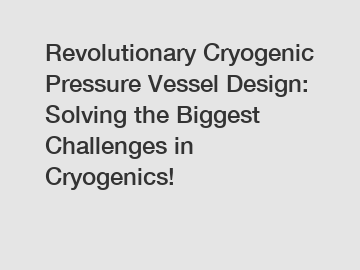Revolutionary Cryogenic Pressure Vessel Design: Solving the Biggest Challenges in Cryogenics!
Revolutionary Cryogenic Pressure Vessel Design: Solving the Biggest Challenges in Cryogenics!
Cryogenics, the branch of physics that deals with the production and effects of very low temperatures, has made significant progress in recent years. However, the biggest challenge in this field lies in the design and construction of cryogenic pressure vessels. These vessels are used to store and transport cryogenic fluids, such as liquefied natural gas (LNG), and they need to withstand extreme cold temperatures and high pressures. In this article, we will explore a revolutionary cryogenic pressure vessel design that addresses these challenges and its significance and impact in the field of cryogenics.
The cryogenic pressure vessel design we are talking about is based on advanced composite materials and innovative manufacturing techniques. Traditionally, cryogenic vessels were made of metals, such as steel, which have limitations when it comes to low-temperature applications. Metals tend to become brittle at extremely low temperatures, increasing the risk of vessel failure. Moreover, metal vessels are heavy and require additional insulation to prevent heat transfer. This not only adds to the overall weight and size of the vessel but also increases the cost of the system.

The revolutionary design, on the other hand, utilizes composite materials, such as carbon fiber-reinforced polymers (CFRP), which offer exceptional properties for cryogenic applications. CFRP composites have excellent strength-to-weight ratio, high thermal stability, low thermal conductivity, and good fatigue resistance. These properties make them ideal for cryogenic pressure vessels as they can withstand the extreme cold temperatures and high pressures without compromising safety and performance.
The manufacturing process of these cryogenic pressure vessels involves winding carbon fiber tapes around a mandrel and impregnating them with a resin matrix. This winding process allows for better control over the thickness and orientation of the composite layers, resulting in a vessel with optimized mechanical properties. Moreover, the use of CFRP composites eliminates the need for additional insulation, making the vessel lighter and more compact.
The significance of this revolutionary cryogenic pressure vessel design is multifold. Firstly, it addresses the biggest challenges in cryogenics by providing a solution that can safely store and transport cryogenic fluids at extreme temperatures and pressures. This opens up new possibilities for various industries, such as energy, healthcare, and transportation, where cryogenic fluids are extensively used.
Secondly, the use of composite materials in cryogenic pressure vessel design offers numerous advantages over traditional metal vessels. The lightweight nature of CFRP composites reduces the energy required for transportation and installation, resulting in cost savings and lower environmental impact. Additionally, the improved mechanical properties of composites extend the lifespan of the vessels, reducing maintenance and replacement costs.
Lastly, this revolutionary design has the potential to accelerate the adoption of clean and sustainable energy sources, such as LNG. As the demand for LNG increases, efficient and reliable cryogenic storage and transportation systems become essential. The use of innovative composite materials in cryogenic pressure vessels enables the expansion of LNG infrastructure, facilitating the transition to a greener energy future.
In conclusion, the revolutionary cryogenic pressure vessel design based on advanced composite materials and manufacturing techniques offers a solution to the biggest challenges in cryogenics. With exceptional mechanical properties and improved efficiency, these vessels have the potential to revolutionize various industries and pave the way for a more sustainable future.
For more information, please visit Liquid Nitrogen Micro Bulk Tank, Ln2 Micro Bulk Tank, Liquid Natural Gas Micro Bulk Tank.
120
0
0


Comments
All Comments (0)